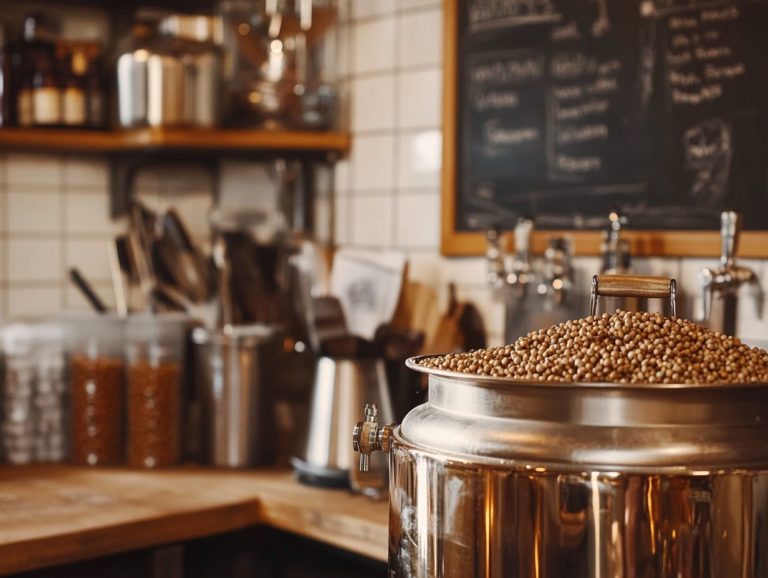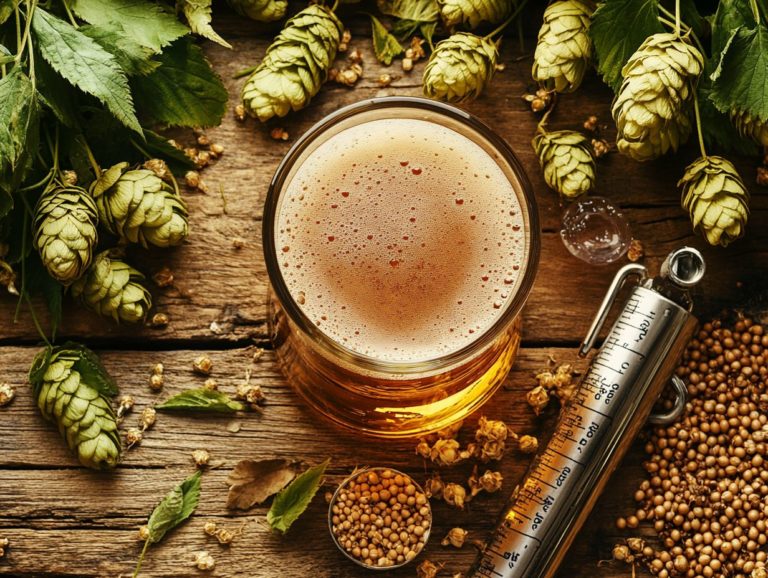Home Brewing Tips for New Ingredients
Exploring new ingredients in homebrewing can invigorate your creations and elevate your brewing skills to exceptional heights. From experimenting with new hop varieties to incorporating specialty malts, each ingredient can transform your brews.
This article presents essential insights into experimenting with new flavors, guiding you through the process from crafting small batches to mastering the art of harmonious combinations. You’ll learn about using high-quality ingredients like malt extracts and additional ingredients like fruits and spices to perfect your brews.
You’ll discover unique recipes that showcase fruit-infused beers and floral kombucha, along with valuable troubleshooting advice for common brewing challenges. The article also highlights insights from experts like Prof. Dr. Anton Piendl of Weihenstephan Brewing Science at the Technical University of Munich.
Get ready to unleash your creativity and elevate your brewing skills! By incorporating techniques from BJCP guidelines and using products from renowned breweries like Guinness and Pilsner Urquell, your brewing can achieve new heights.
Contents
- Tips for Using New Ingredients in Home Brewing
- 2. Experiment with Different Combinations
- 3. Research the Flavor Profiles of New Ingredients
- 4. Consider the Brewing Process
- Recipes for Home Brewing with New Ingredients
- Troubleshooting Common Issues with New Ingredients
- 1. Off-flavors
- 2. Cloudy Appearance
- 3. Slow Fermentation
- Frequently Asked Questions
- What are some tips for using new ingredients in my homebrewing?
- Can I substitute new ingredients for traditional ones in my homebrew recipe?
- What are some common mistakes to avoid when using new ingredients in homebrewing?
- How can I incorporate new ingredients into different styles of homebrew?
- What are some recommended new ingredients to try in homebrewing?
- Do I need any special equipment to use new ingredients in my homebrew?
Key Takeaways:
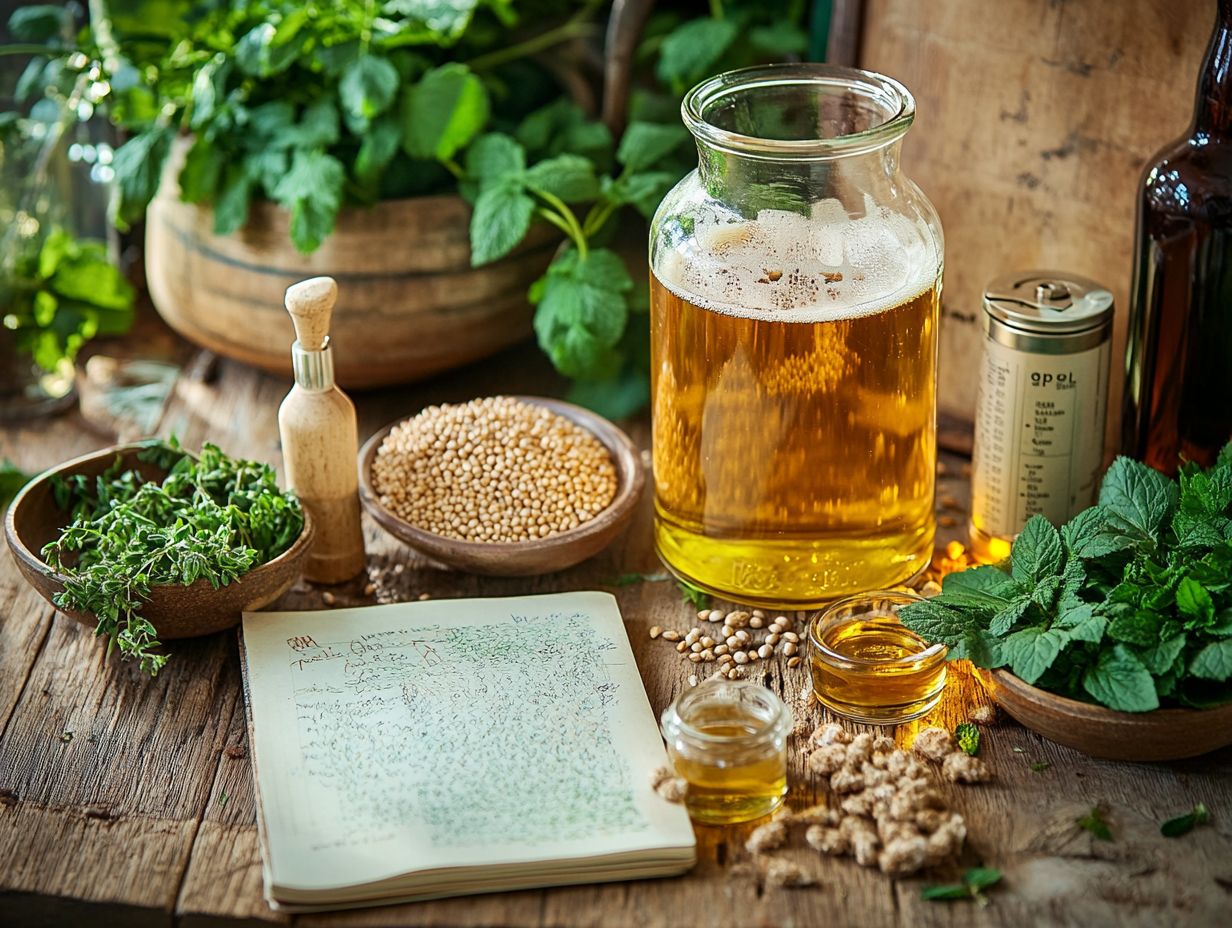
- Start small to avoid wasting ingredients and ensure tasty results!
- Get creative and experiment with different combinations of new ingredients to discover unique flavors. Consider blending base malts with Munich malt or Carapils to find the perfect balance.
- Research the flavor profiles of new ingredients before using them in a brew to ensure they complement the overall taste. Utilize resources like HomebrewersAssociation.org and BeerSmithRecipes.com for detailed ingredient insights.
Tips for Using New Ingredients in Home Brewing
In the realm of homebrewing, embracing new ingredients can truly elevate your creations. Whether you’re diving into specialty malts like caramel or roasted varieties or adding additional ingredients like fruits and spices, grasping how these premium ingredients interact with your traditional brewing components like yeast, hops, and water is crucial.
Each ingredient holds significant sway over the brewing process, influencing fermentation, flavor, and overall quality. By adopting a systematic approach to incorporating these new ingredients, you refine your brewing skills and craft unique and flavorful beers that genuinely reflect your personal taste.
1. Start with Small Batches
Starting with small batches in homebrewing is a wise strategy, especially when you’re experimenting with new ingredients in your recipes. This approach gives you the freedom to test various flavor profiles and combinations without the risk of committing to a large volume of beer that might not turn out as you hoped. Try out different malt extracts, like dry malt extract or liquid malt extract, to see how they impact your brew.
By brewing in smaller quantities, you can play around with different malts and hops, gaining a deeper understanding of how each component influences the final product. This hands-on experimentation opens the door to creativity, allowing you to tweak recipes and discover unique brews that cater to your personal taste preferences. Don’t forget to use malted grains and additional ingredients to add depth to your brews.
Make it a habit to document each experiment ingredient ratios, tasting notes, everything! This becomes an invaluable reference for future brewing sessions. Not only does this practice sharpen your brewing skills, but it also instills a sense of accomplishment and growth in the ever-evolving craft of homebrewing.
We invite you to share your experiences or questions in the comments below. Let’s inspire each other on this exciting brewing journey!
2. Experiment with Different Combinations
Experimenting with different combinations of ingredients is essential in your homebrewing journey. It unlocks the potential for unique and flavorful brews that truly reflect your creativity.
By adjusting the ratios of base malts, specialty malts like Munich malt, and adjuncts such as fruits or spices, you can uncover exciting new flavor profiles that tantalize the palate. You might even draw inspiration from popular brews like Goose Island or Pliny the Elder.
As you delve into the brewing process, don t overlook the importance of hops and yeast; both are vital to the character of your final product. Hops bring bitterness and aromatic qualities to the table, while yeast significantly influences the beer s mouthfeel (the way the beer feels in your mouth) and fermentation flavors.
By keeping a detailed brewing log, you can meticulously document your ingredient combinations. Keeping track of your brewing will help you learn from mistakes and improve your recipes based on past experiences. This systematic approach fosters continuous improvement, ultimately leading to more satisfying results in your future brews.
3. Research the Flavor Profiles of New Ingredients
Understanding the flavor profiles of new ingredients is essential for your homebrewing success. Each component can dramatically influence the final product.
For instance, using caramel malts can add a delightful sweetness, while roasted malts bring a rich, dark character to the mix. It’s crucial for you to grasp how these elements interact with hops and yeast to craft well-balanced beers. Researching practices from reputable sources can provide valuable insights.
Delving deeper into the specific contributions of various adjuncts is equally important in the brewing process. Adding corn or rice can lighten a beer’s body, making it more refreshing, whereas oats create a wonderfully smooth mouthfeel. These techniques are popular in traditional brews like Chicha.
For aspiring brewers like yourself, researching how these ingredients change different beer styles can be eye-opening and fun! Different hops can impart floral or citrus notes, significantly shaping the beer s aroma.
Utilizing resources like HomebrewersAssociation.org and BeerSmithRecipes.com will provide you with insights into these flavor dynamics. This knowledge will help you make informed decisions that elevate your brewing creations to new heights. Additionally, using products like Star San ensures your brewing environment remains clean and sanitary.
4. Consider the Brewing Process
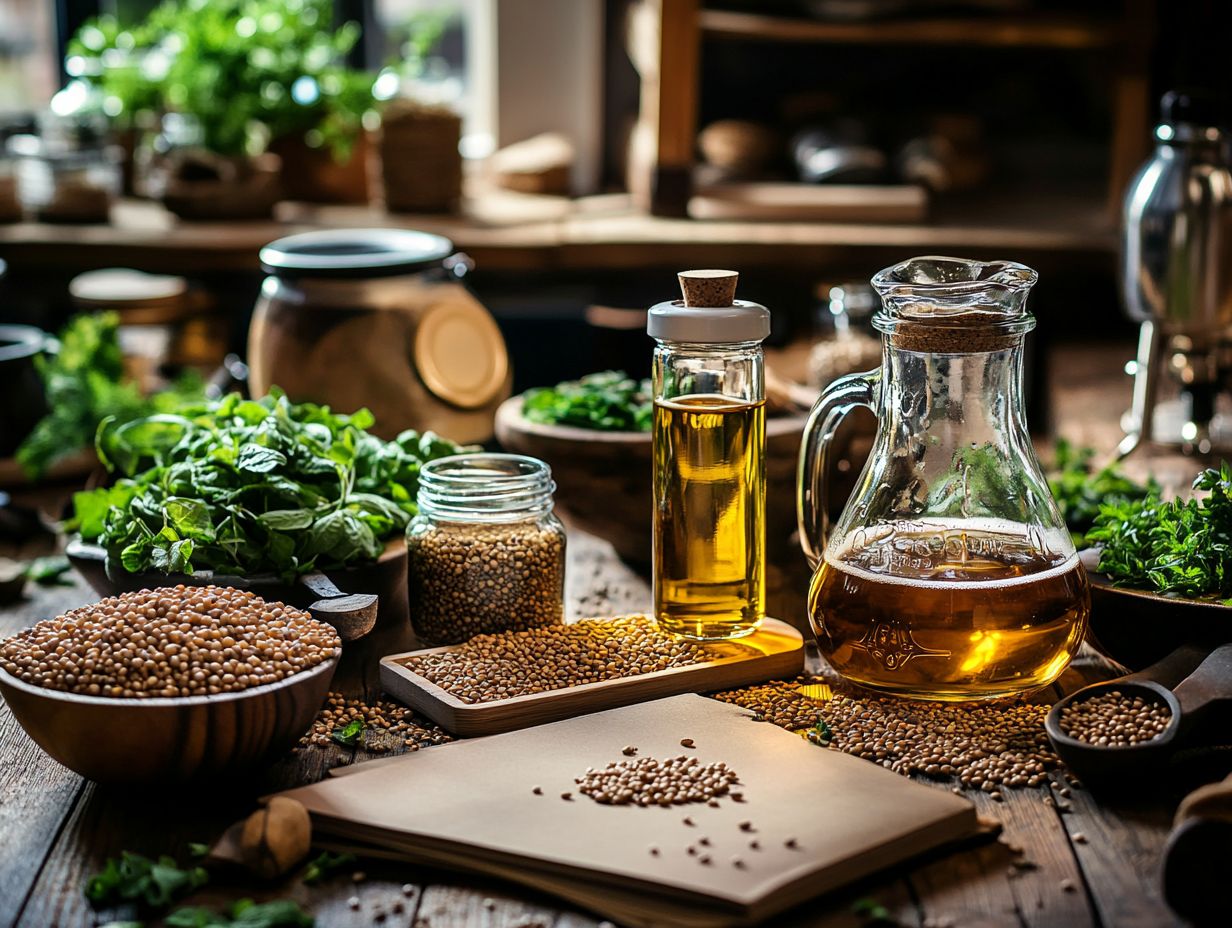
Considering the brewing process is essential when introducing new ingredients. It significantly influences how well flavors meld and develop during fermentation. Each step, from mashing to fermentation, is affected by the types of ingredients you choose, such as malt extracts or adjuncts, and understanding their interactions is key to achieving the results you desire.
For example, your mashing techniques can vary greatly depending on the type of malt you use. When working with specialty malts like Carapils or Munich malt, it s important to pay close attention to temperature control and mash duration to optimize the extraction of sugars and flavors.
The fermentation stage is equally crucial for flavor development, as the yeast transforms sugars into alcohol while producing various esters and phenols that contribute to the beer’s aroma and taste.
By experimenting with unique ingredients and techniques throughout these stages, you can create distinct profiles that elevate your craft and captivate beer enthusiasts. This makes it essential to monitor each phase carefully to ensure optimal results.
Recipes for Home Brewing with New Ingredients
Don t wait! Start crafting your own recipes now to unlock exciting new flavors and aromas that showcase your personal style. Crafting recipes for home brewing with new ingredients enables you to push the boundaries of flavor.
Whether you’re experimenting with fruit-infused beers or spiced ciders, each recipe can be tailored to showcase unique ingredients think high-quality malts, hops, or intriguing adjuncts. Drawing inspiration from renowned recipes like those of Pliny the Elder can provide a great starting point.
This approach opens the door to a captivating array of exciting flavors and aromas, transforming your brewing experience into an exploration of creativity and taste.
1. Fruit-infused Beer
Fruit-infused beer offers a delightful opportunity to incorporate fresh flavors into your brews. This provides a refreshing twist that can captivate a wide audience. By introducing fruits like raspberries or citrus during fermentation, you can craft a unique flavor experience that beautifully complements the base malts and hops. Referencing methods from brews like Pilsner Urquell can guide your experimentation.
When enhancing your brewing process, it’s essential to consider the types of fruit you choose. Certain varieties blend better with specific beer styles. For instance, stone fruits such as peaches and apricots can enhance the sweetness of wheat beers, while dark berries create a stunning harmony with stouts and porters.
Timing plays a pivotal role as well. Adding fruit during primary fermentation facilitates perfect flavor integration. In contrast, late additions in secondary fermentation can preserve the fruit’s vibrancy and aroma. Striking a balance between the sweetness of the fruit and the bitterness of the hops, along with the malt base, will lead to a well-rounded brew that truly excites the palate.
Try experimenting with your own fruit-infused beer recipes; you might just discover your new favorite brew!
2. Spiced Cider
Brewing spiced cider offers an exceptional opportunity to experiment with new ingredients. You can meld traditional apple flavors with warm spices like cinnamon and nutmeg. This delightful combination creates a cozy, aromatic beverage that will impress your guests at any gathering. By drawing inspiration from iconic brews, you can create a memorable cider.
To embark on this flavorful journey, selecting the right apples is paramount. A blend of sweet varieties, such as Fuji and Honeycrisp, paired with tart options like Granny Smith, will yield a well-rounded taste. Regarding spices, think about incorporating cloves, allspice, and perhaps a touch of ginger to elevate the complexity of your cider.
Once you’ve juiced the apples and introduced the spices, the fermentation process begins. This step involves adding yeast, which transforms the sugars in the apple juice into alcohol. Monitor both the fermentation duration and temperature carefully to achieve a balanced flavor profile, ensuring that the resulting cider is both aromatic and refreshingly delightful. Explore tools and techniques from brewing experts to enhance the process.
Try your hand at brewing spiced cider and enjoy the comforting flavors it brings to your home!
3. Herb-infused Mead
Herb-infused mead presents an intriguing avenue for you to delve into the art of brewing. It merges the sweetness of honey with the vibrant essence of fresh herbs to create a drink that s both complex and aromatic. Imagine enhancing your mead with herbs like rosemary or thyme, transforming it into a unique sensory experience. Following guidance from brewing authorities like those at the Beer Judge Certification Program (BJCP) can help refine your mead.
To begin this creative brewing adventure, selecting high-quality honey is essential; its natural sweetness will beautifully complement the herbal infusion. Next, you’ll want to choose your herbs wisely. Delicate options like chamomile can provide a soft floral note, while bolder herbs might add robust earthy flavors.
For infusion techniques, consider steeping your chosen herbs in hot water before combining them with honey and water. This method effectively extracts the essential oils, enriching your mead. However, balance is key; over-infusing can eclipse the honey’s sweetness. Regularly tasting during the process will help you achieve that perfect harmony between sweetness and herbal character. This practice is recommended by experts like Weihenstephan Brewing Science.
Get creative and try your hand at brewing herb-infused mead for a truly unique beverage experience!
4. Coffee-Flavored Stout

Dive into the rich, robust world of coffee-flavored stout! It elegantly marries the deep flavors of roasted malts with the invigorating essence of coffee.
This brew will undoubtedly delight any coffee aficionado. By incorporating cold-brewed coffee during fermentation, a technique perfected by breweries like Goose Island, you can achieve a harmonious balance between the malt and coffee flavors.
This distinctive style of beer typically showcases a blend of specialty malts, including chocolate, crystal, Carapils, and roasted barley. These malts contribute to its enticing dark color and complex palate. When selecting your coffee, opt for a medium to dark roast that beautifully complements the stout’s natural sweetness. For inspiration, check out recipes on BeerSmithRecipes.com.
Brewing techniques are important. Preparing the coffee as a cold brew not only preserves its subtle nuances but also ensures that excessive bitterness doesn t seep into the final product. Timing is also essential adding the cold brew at the right moment during fermentation can amplify the aromatic qualities without overshadowing the stout’s intrinsic character.
Taking notes from renowned brews like Guinness can be highly beneficial in perfecting your stout. Don’t miss out on the chance to create a perfect brew that impresses your friends!
5. Floral-Infused Kombucha
Floral-infused kombucha offers a refreshing and aromatic twist on traditional fermented tea. This makes it an excellent choice for home brewing with unique ingredients.
By incorporating floral notes from delightful ingredients like hibiscus or chamomile, you can craft a light and fragrant beverage that dances with herbal and floral flavors. Expert guidance can often be found at HomebrewersAssociation.org.
The process begins with selecting high-quality dried flowers or even fresh blooms. You can steep these in the tea base during the initial fermentation or in a second fermentation, where the kombucha ferments again for added flavor.
Timing becomes your secret ingredient; a shorter infusion will yield a subtle floral hint, while a longer steep allows the rich aromas to fully flourish. Striking the right balance between the natural sweetness of the sugars and the drink’s acidity is crucial to ensure that one does not overpower the other.
For a successful brew, consider using yeast strains recommended by Technical University of Munich. Achieving this delicate equilibrium results in a kombucha that tantalizes the palate and enchants the senses with its vibrant aroma. Each sip becomes an invigorating experience.
Troubleshooting Common Issues with New Ingredients
Troubleshooting common issues with new ingredients can prevent mishaps and elevate the quality of your final product. Whether you’re contending with off-flavors or a cloudy appearance, grasping the root causes of these problems is crucial for successful fermentation and brewing.
Utilizing reliable sanitizers like Star San can greatly reduce potential issues.
1. Off-flavors
Off-flavors in your home brewed beer can emerge from a variety of factors, such as poor ingredient quality, inappropriate fermentation temperatures, or contamination during the brewing process. Identifying and addressing these issues is essential for creating a clean and enjoyable final product. Consulting BeerSmith brewing software can help you monitor these variables effectively.
One of the most common culprits of off-flavors is the use of stale or low-quality malt, which can introduce unwanted astringency or oxidation characteristics. If you re using old or rogue hops, you might end up with grassy and herbal notes that simply don t belong. Fermentation temperature is another critical factor; fermenting at too warm a temperature can lead to the production of esters and fusel alcohols, resulting in fruity or solvent-like flavors. Using dry malt extract or liquid malt extract can help ensure higher quality and consistency.
To ensure the integrity of your brew, always choose fresh, high-quality ingredients and maintain optimal sanitation practices. Regularly cleaning your equipment and utilizing proper storage methods can significantly reduce the risk of contamination, guaranteeing a consistently delightful experience for both you and those who get to enjoy the final product. Renowned experts such as Prof. Dr. Anton Piendl emphasize the importance of these practices.
2. Cloudy Appearance
A cloudy appearance in your home-brewed beer can stem from excess proteins, yeast, or improperly processed grains, raising concerns about clarity and visual appeal. By understanding the factors behind this issue, you can achieve a clearer and more attractive final product. Applying techniques used in Pilsner Urquell can be advantageous.
One significant contributor to haze is the interaction between proteins and polyphenols during the brewing process. To tackle this, focus on implementing proper mashing techniques. Ensure that both the temperature and duration are optimized to extract the desired sugars while minimizing protein solubility. You might also consider using Munich malt for better results.
Using effective filtration systems or incorporating fining agents can greatly enhance clarity by removing suspended particles. Additionally, the selection of ingredients plays a crucial role. Opt for grains with lower protein content or specific yeast strains that clump together well. This thoughtful approach not only elevates the visual appeal of your brew but also ensures it tastes exceptional. For an exceptional finish, consider Carafa Special malts.
3. Slow Fermentation
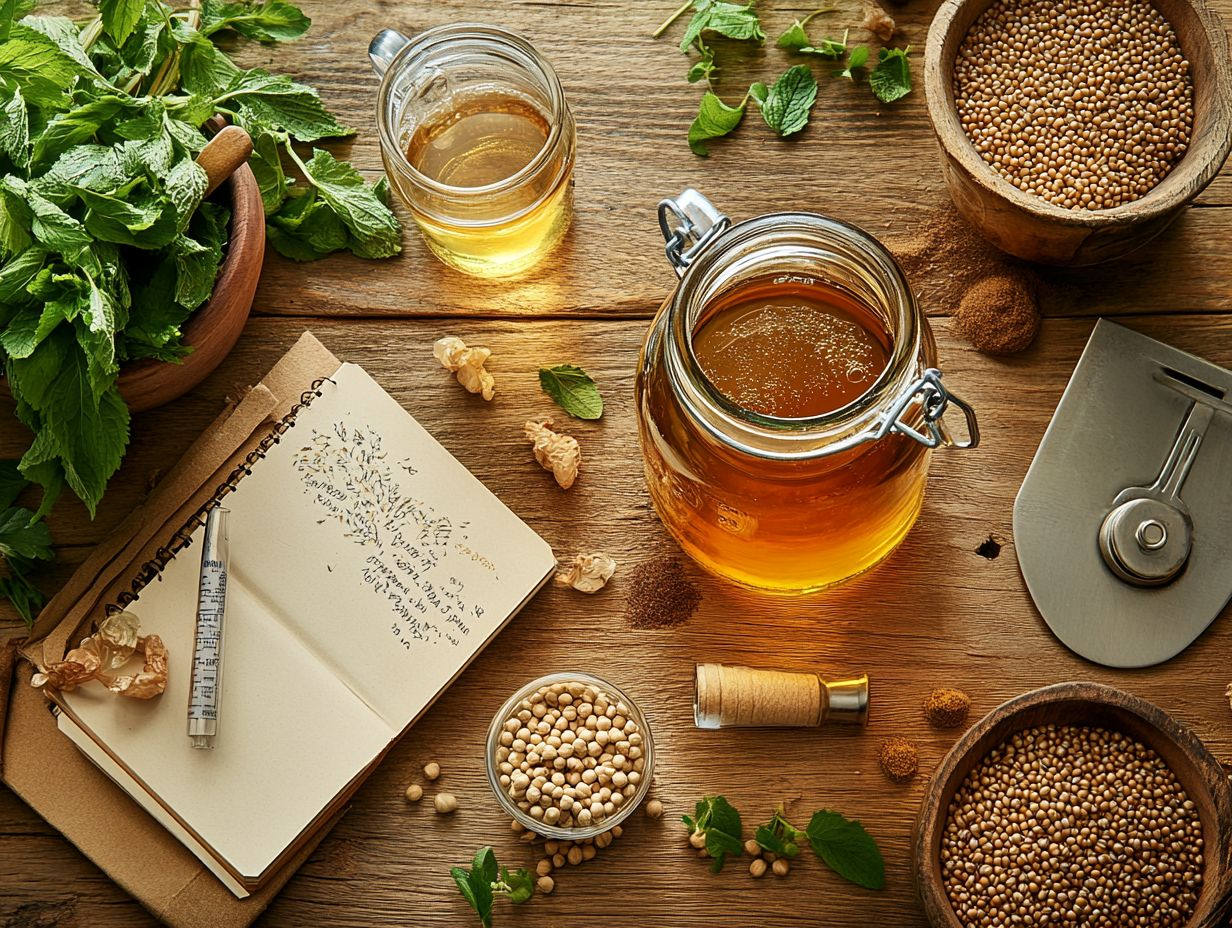
Slow fermentation can be quite the headache for homebrewers like yourself, often stemming from insufficient yeast activity or incorrect fermentation temperatures. It s crucial to address this issue swiftly to ensure your beer achieves its intended flavor profile and carbonation levels. Reference classic brews like Pliny the Elder for ideal fermentation practices.
Several factors contribute to this sluggish process, with inadequate yeast pitch rates and poor temperature control being the main offenders. When you don t pitch enough yeast, it struggles to kick off and maintain vigorous fermentation, leading to a slow conversion of sugars into alcohol. Fluctuations in fermentation temperature can hamper yeast performance, putting it under stress and causing a decline in metabolic activity.
To promote healthy fermentation, consider these tips:
- Pitch the right amount of yeast tailored to your batch size and style.
- Maintain a stable fermentation temperature within the yeast’s optimal range.
By prioritizing these adjustments, you can unlock the full potential of yeast in your brewing process and achieve a truly delightful end product. Start brewing today and perfect your technique!
You should also explore traditional beverages like Chicha for unique brewing inspiration.
Frequently Asked Questions
This section will cover common queries about home brewing practices, tips, and troubleshooting.
In conclusion, understanding the nuances of brewing can elevate your home brew to new heights. Remember to experiment, learn, and enjoy the process!
When experimenting with new ingredients in your homebrew, it’s important to start with small amounts and gradually increase to find the right balance. Do some research on the ingredient beforehand to understand its flavor profile and how it can impact your brew.
What are some tips for using new ingredients in my homebrewing?
Yes, you can definitely substitute new ingredients for traditional ones in your homebrew recipe. Remember, this may change the taste and result of your brew. Make adjustments accordingly and taste test along the way.
Can I substitute new ingredients for traditional ones in my homebrew recipe?
One common mistake is using too much of the new ingredient, which can overpower other flavors in your brew. Another mistake is not properly sanitizing the new ingredient, which can lead to contamination and off-flavors in your final product. Follow proper brewing practices when using new ingredients.
What are some common mistakes to avoid when using new ingredients in homebrewing?
The possibilities are endless when it comes to incorporating new ingredients into different styles of homebrew. You can add fruits, herbs, spices, or different types of grains to your recipe. Just think about how it will taste and how it will complement the style of beer you are brewing.
How can I incorporate new ingredients into different styles of homebrew?
Some popular new ingredients to experiment with in homebrewing include honey, coffee, chocolate, and various types of hops. Get adventurous! Try using unconventional ingredients like tea, pumpkin, or even bacon for exciting flavors in your brew! Don t miss out on the fun of experimenting with unique ingredients!
What are some recommended new ingredients to try in homebrewing?
No, you do not need any special equipment to use new ingredients in your homebrew. However, depending on the ingredient, you may need to make adjustments to your brewing process. For example, if using fresh fruit, you may need to puree it or use a mesh bag to extract the flavor without adding additional sediment to your brew.


